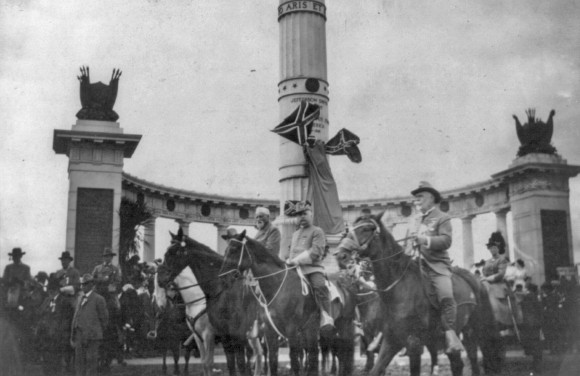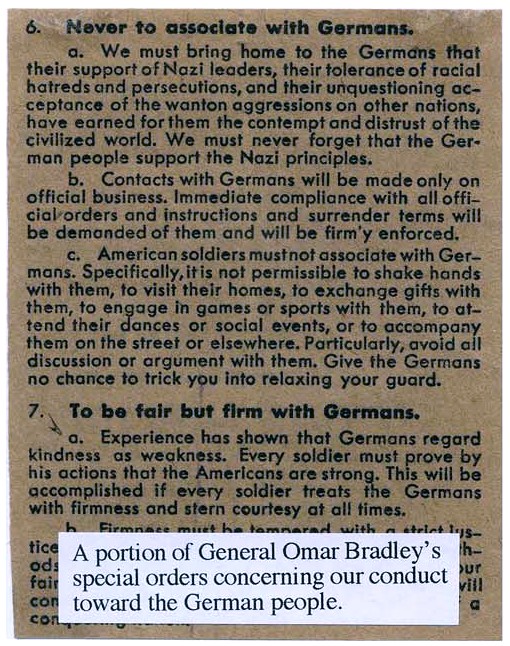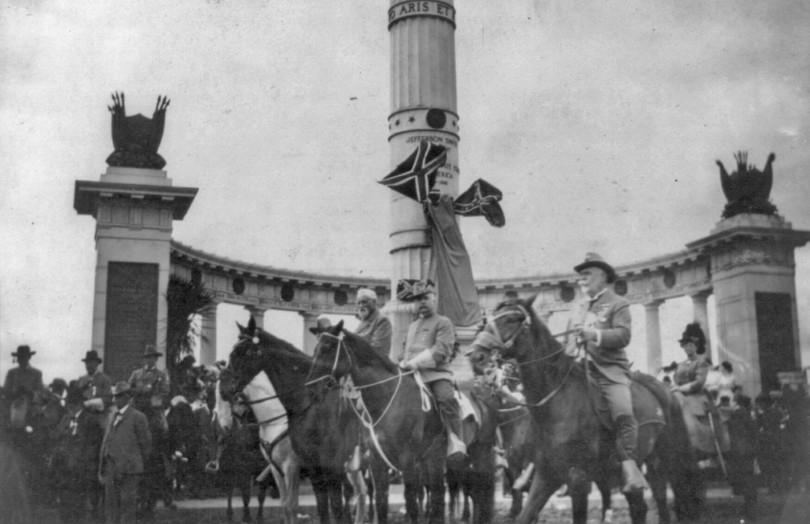aNewDomain — The Confederacy had no redeeming features. None. The Confederacy rivaled the Nazis in an evil thankfully cut short by the sacrifices of U.S. troops. Anyone alive in 2015 with a soft spot for the Confederacy is either racist or under the sick spell of propaganda constructed 150 years ago by the same arrogant racists who started the war.
To be clear, the Confederacy is not and never was the South. The Confederacy was a political philosophy that promoted institutional slavery and considered Africans not much more advanced than cattle. Confederate Vice President Alexander Stevens laid the philosophical foundations of the Confederate government in his Cornerstone Speech on March 21, 1861:
Our new government is founded upon exactly the opposite ideas; its foundations are laid, its cornerstone rests, upon the great truth that the negro is not equal to the white man; that slavery, subordination to the superior race, is his natural and normal condition.”
Sensing opposition to the removal of the Confederate Flag as a rich opportunity for harvesting followers, Fox News and Rush Limbaugh have begun rallying their conservative devotees for yet another Right versus Left political dustup.
If defeating Confederate ideology in 2015 is a Right versus Left argument, then we’re in deep trouble.
A better idea? Something akin to the de-nazification programs that were so effective in ridding Germany of Nazi symbolism after World War II. Let me explain …
Note: In this article, I do not use the word “Union.” The U.S. Army — augmented by state volunteers — fought and defeated the Confederacy.
The Brilliant “Lost Cause” Propaganda
In 1865, while the U.S. government bickered among itself about how to deal with the defeated Confederacy, the intellectual apologists for the Confederacy were already hammering together a brilliant piece of self-perpetuating propaganda known as “The Lost Cause” that still operates today 150 years after its creation.
The Lost Cause attempts to reconcile a sanitized version of the Antebellum South (think “Gone with the Wind“) with defeat of the Confederacy during the Civil War, and attempts to rationalize the rebellion as ultimately having at its core something beyond the right to own other human beings. In fact, the Lost Cause will do or say almost anything to distract you from the issue of slavery.
The Lost Cause also includes attacks, sometimes veiled, sometimes not, against African Americans and U.S. authorities (think “Birth of a Nation“). Of course, if the Lost Cause is forced to discuss slavery, then it’s typically described as a benign institution … but they’d much rather have you think about “honor” and “tradition,” without really defining those terms either.
Explaining, rationalizing, justifying the horrors inflicted by the slave owners and the Confederacy on African Americans is a critical element to the propaganda. The Confederate apologists have an excuse for nearly every horror inflicted.
The Lost Cause propaganda has spawned numerous organizations, publications and ceremonies over the years, such as this parade at a Jefferson Davis monument in 1907, led by the eldest son of Robert E. Lee:

Imagine the outrage if 42 years after the defeat of Nazi Germany (1987), the grandson of Hermann Göring had led a memorial parade through the Brandenburg Gate on horseback with swastikas flying.
De-Nazification Worked Wonders
Ever wonder why victorious German sports teams don’t wildly waive the Nazi flag at all, let alone with the same gusto that produces the Stars and Bars? There’s a simple answer — apart from being against German law, the Allies post-war de-nazification program removed the Germans’ taste for the Nazis.

When the Allies conquered the Nazis, they initially blamed all Germans. General Omar Bradley, for example, issued a seven-point directive to his soldiers that began: “Remember always that Germany, though conquered, is still a dangerous enemy nation.” The third point of Bradley’s directive is particularly instructive:
3. To defeat German efforts to poison my thoughts or influence my attitude.
a. The Nazis have found that the most powerful weapon is distortion of a truth. They have made skillful use of it and will re-double their efforts in the event of and occupation in order to influence the thinking of the occupational forces. There will probably be deliberate, studied and continuous efforts to influence our sympathies and to minimize the consequences of defeat.
b. You may expect all manner of approach; conversations to be overheard, underground publications to be found; there will be appeals to generosity and fair play; to pity for victims of devastation; to racial and cultural similarities; and to sympathy for an allegedly oppressed people.
c. There will be attempts at sowing discord among Allied nations; at undermining Allied determination to enforce the surrenders; at inducing a reduction in occupational forces; at lowering morale and efficiency of the occupying forces; at proving that Nazism was never wanted by the “gentle and cultured” German people.
Substitute “Confederate” every time you see the word “Nazi,” and you’ll have a better idea of what should have been done during Reconstruction to defeat the Lost Cause.
But the Allies realized that blaming all Germans and not just the Nazis would thwart the healing that would ultimately be necessary and could well lead to prolonging the fascist cause. Plus the Allies knew that many Germans had resisted Hitler from Protestant theologians like Dietrich Bonhoeffer to German soldiers like Admiral Wilhelm Canaris, both of whom were executed by the Nazis.
The Allies created a de-nazification program which still exists, more or less, today. The program included the following elements:
- Removal and destruction of all physical symbols of the Nazi regime. This included destroying all Nazi images in public places and forbidding the display of Nazi emblems like the swastika.
- Identifying and ranking the 10 percent of the German population who had been members of the Nazi party. These Nazis were sorted into various groups from “followers” to “lesser offenders” to “offenders” and “major offenders.” Each group was subject to punishment of some sort, with the major offenders subject to imprisonment and possible execution, such as judgment at the Nuremburg Trials.
- For a time, the Allies controlled the message put forth by German media — 37 German newspapers, six radio stations, 314 theaters, 642 cinemas, 101 magazines, 237 book publishers and 7,384 book dealers and printers.
- The Allies allowed the Germans to slowly regovern themselves with leaders having no or minimal Nazi associations.
- The Allies began a program of creating a sense of collective guilt among all Germans for the atrocities committed during the war.
German civilians were sometimes forced to witness Nazi atrocities presumably performed for their benefit, such as these slave laborers executed by SS soldiers near the war’s end:

De-nazification achieved its aims but over time the program began to slow. Germany’s first post-war leader, Konrad Adenaur, opposed de-nazification as no longer effective since so many former Nazis had been caught and punished. The new German government adopted policies that mirrored those of de-nazification. It is still, for example, a criminal offense in Germany to display the Nazis’ swastika flag.
Germans were not prevented from recognizing the heroism of German soldiers during the war, no matter how misguided the war was. So, Germans today can admire the bravery of an ace pilot like Gunther Rall.
The course of de-nazification, both the official Allied version and the post-war German government’s version, has succeeded in removing a taste for the Nazis among Germans. Recent surveys show that most Germans now see themselves as victims of the Nazis, and other surveys show that only a small handful of Germans want the country to take an active role in foreign affairs.
So, de-nazification worked.
Various truth and reconciliation commissions, such as the post-apartheid South African Truth and Reconciliation Commission, offer another approach for erasing the abuses of a past regime, killing its propaganda, and allowing people to move forward. Under some circumstances such commissions may even be more effective in wiping away the appetite for a previous regime than programs like de-nazification.
Neither of these approaches were attempted in the post-war Confederacy.
The Myths of Slavery
It’s shocking that 150 years after the ratification of the 13th Amendment ending slavery, Lost Cause propaganda still manages to convince some people that slavery was benign.
Here are some facts regarding Antebellum Slavery:
- Slaves had a life expectancy lower than that of their masters.
- Slaves lived in poor conditions.
- Slaves had no freedom of movement.
- Slaves had to work at the pace set by their masters or face punishment.
- Slave owners could punish or kill their slaves with no consequences.
- Slave owners could rape their slaves with no consequences.
- Slave owners could sell the children of slaves with no consequences.
More than 2 million Africans died just in being transported across the Atlantic. Some estimates are higher.
Lost Cause propaganda taints all Southerners with slavery or a desire to own slaves. By tainting every Southern white person with slavery, the Confederates make all Southerners Confederates. Only about a third of Southerners owned slaves. Nearly 90 percent of the Southerners who owned slaves owned fewer than 20. In 1850, just 125 plantations had over 250 slaves. Thus, the Confederates were truly an elite with more money, better educations and more resources than nearly anyone they encountered — the Lost Cause has never lacked for funds.
You Can’t Call This Honor.
A key plank of the Lost Cause is that the Confederates were honorable, more honorable than the U.S. authorities and U.S. soldiers and more honorable than their African American slaves.
This is a photograph of U.S. Army private Phillip Hattle taken at St. John’s College U.S. General Hospital in Annapolis, Maryland a few days before he died in 1865. Hattle was one of the 13,000 U.S. Army soldiers starved at the infamous Confederate prison at Andersonville.

If you were an American soldier, and you had to be captured, who would give you better odds – the Nazis or the Confederates? Answer: the Nazis would have treated you with more dignity.
Of the 93,941 American soldiers captured by the Nazis, only 1,124 of them died in captivity. That’s a little more than 1 percent.
Of the 45,000 American soldiers held at Andersonville, 13,000 of them died in captivity. That’s 29 percent.
Doesn’t sound too honorable, does it?
Of course, like all things related to the Confederacy, there are a lot of apologies and excuses for Andersonville. Some of them are likely mitigating circumstances. But there were other options.
The camp’s commander, Confederate Captain Henry Wirz, was hanged after the war not only for his treatment of captured American soldiers but for killing 13 of them by: personally shooting them with his revolver, by physically stamping and kicking the victim, by confining prisoners in stocks, by beating a prisoner with a revolver and by chaining prisoners together.
Of course, like all things related to the Confederacy, there are lots of excuses for Capt. Wirz. Some of them may be true.
You’ll notice that Private Hattle was a white American soldier. African American soldiers fared worse.
What’s the worst atrocity inflicted on U.S. soldiers in war? If you’ve been glued to the History Channel, you might say it was the Malmady Massacre during the Battle of the Bulge, when 84 American prisoners were shot by the Nazis. But you’d be wrong. (The Malmady Massacre resulted in 43 death sentences after the war that were later commuted to life imprisonment.)
The worst atrocity inflicted on U.S. soldiers occurred at Fort Pillow on April 12, 1864 when nearly 300 U.S. soldiers were cut down while attempting to surrender.
The commander of the Confederate forces at Fort Pillow was a former slave trader named Nathaniel Bedford Forrest. After the war, he founded the Ku Klux Klan.
Of course, there are apologies for Forrest’s behavior at Fort Pillow.
Champ Ferguson and Henry Wirz were the only two Confederates to be executed for war atrocities. Ferguson was tried for killing 53 U.S. soldiers during the Battle of Saltville. Unlike the Fort Pillow massacre, the Saltville massacre involved the murder of both black and white U.S. soldiers.
Of course, there are apologies for Ferguson’s behavior during the Battle of Saltville.
A key element of the Lost Cause is the nobility of Confederate soldiers and the crudeness of the U.S. Army. Oh please.
Most Confederate soldiers likely fought with dignity, and some U.S. army soldiers likely did not. But the claim of unique nobility for the Confederate forces is one of the many lies underpinning the Lost Cause propaganda.
Civil War Reconstruction
After the defeat of the Confederacy, U.S. authorities first followed policies somewhat similar to General Bradley’s directive. The federal government was divided, and the postwar policies were largely incoherent.
If U.S. authorities had followed a de-confederization policy along the lines of the de-nazification policy, then the following would have happened:
- All signs and symbols of the Confederacy would have been destroyed and banned forever (in 1865 not 2015.)
-
The former leaders of the Confederacy would have been classified into groups such as “followers” to “lesser offenders” to “offenders” and “major offenders.”
This step would have almost certainly meant trial for treason and execution for all the leaders of the former Confederacy. As matters unfolded, not even Jefferson Davis was tried for treason, although he was indicted for treason. Robert E. Lee was not even imprisoned.
This step would have also meant that ordinary Confederate soldiers would have been as absolved from wrongdoing as were ordinary members of the Wehrmacht after World War II.
In its uneven policies, the federal government did include a provision in the 14th Amendment that prevented former Confederates from becoming members of the U.S. government:
Section 3. No person shall be a Senator or Representative in Congress, or elector of President and Vice President, or hold any office, civil or military, under the United States, or under any State, who, having previously taken an oath, as a member of Congress, or as an officer of the United States, or as a member of any State legislature, or as an executive or judicial officer of any State, to support the Constitution of the United States, shall have engaged in insurrection or rebellion against the same, or given aid or comfort to the enemies thereof. But Congress may, by a vote of two-thirds of each House, remove such disability.”
This provision prevented Jefferson Davis from becoming a U.S. senator in 1875. Davis was even offered the position of first president of Texas A&M in 1876.
None of the Confederate leaders ever apologized for their racist beliefs. Davis, in particular, continued writing justifications for racism until his last breath.
De-Confederization in Our Time
A policy of de-Confederization is 150 years overdue. The measures that could have ended any philosophical underpinnings for the Confederacy were not taken in the aftermath of the Civil War.
They cannot now be undertaken in the same manner as they should have then.
To ban Confederate images and pro-Confederate organizations now would almost certainly require a constitutional amendment.
One simple step should be the elimination of Confederate images on any object produced under the authority of a state or federal government. On June 18th, the U.S. Supreme Court ruled that states were within their rights to refuse Confederate images from state-issued license plates.
A second simple step would be for corporations to understand the price that they could pay for sponsoring events and organizations that include Confederate imagery.
A third more complicated step involves education. Deconstructing and destroying the Lost Cause propaganda will not be an easy task. A first step is separating Southerners from the Confederacy. At present, many Southerners believe that an attack on the Confederacy is an attack on them, and that only helps the Lost Cause propaganda. A second step involves ending any further romanticization of the Antebellum South.
The Real Heroes of The South – One Mother’s Tale
My father’s family includes several Confederate soldiers from Texas. I’m sure they completed their military service with honor and dignity. They also owned slaves.
One of these slaves was a woman named Hannah who had been sold separately from her daughter. After emancipation, she wanted to return to Alabama to find her daughter. According to family legend, my great-grandmother told her how perilous the journey would be for a single woman to walk from east Texas to Alabama alone and with no resources. Hannah insisted that nothing was more important than finding her daughter. So, my great-grandmother helped her pack some food for the journey.
Hannah left their farm on foot, blending into a sea of displaced persons and became lost to history. No one in the family knows if she ever reached Alabama or found her daughter.
When we finally name colleges after women brave enough to undertake a 600-mile journey on foot with no resources in order to find their stolen child, then I might possibly be willing to listen to the “injustices” put on a man in a hand-tailored uniform, sitting on a white horse, who despite having one of the finest educations in the humanities available in his day nevertheless chose to exercise that matchless education in a war to enshrine the perpetuation of one of the most evil ideas ever cooked up by the human race. Until then, go to hell.
For aNewDomain, I’m Tom Ewing.
Photo credits:
Washington Custis Lee on horseback at Davis Memorial in Virginia in 1907.
Composite of rebel partygoer and altered photo of 2014 FIFA champions.
General Omar Bradley’s order to Allied soldiers regarding fraternization with Germans, author’s collection.
U.S. Army Private Phillip Hattle.
German woman being forced to see slave workers shot by Nazis.














I think getting rid of douchebag lawyers would help the country more than getting rid of the Confederate Battleflag…
The only way to make this happen is to gut the First Amendment. No thanks. Ewing and friends need to put on their big boy pants and accept that in a society that respects personal freedom, your feelings will sometimes be hurt. People will say offensive things. Sometimes they’ll express themselves in offensive ways. That’s the price we pay to be allowed to speak and express ourselves freely. It’s actually a pretty good deal.